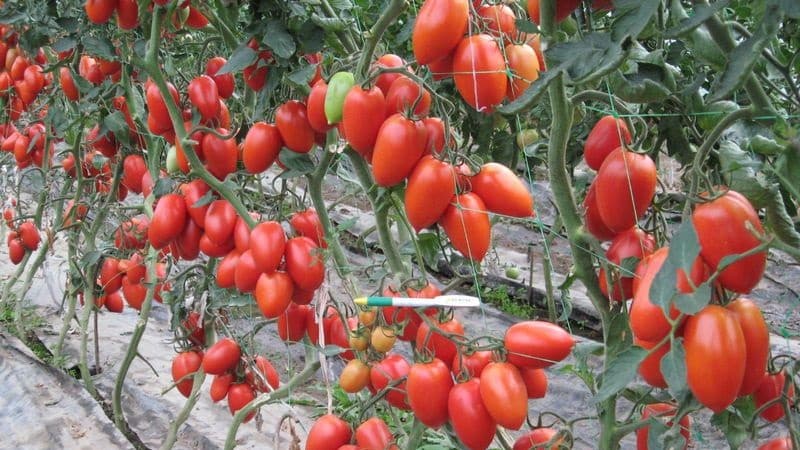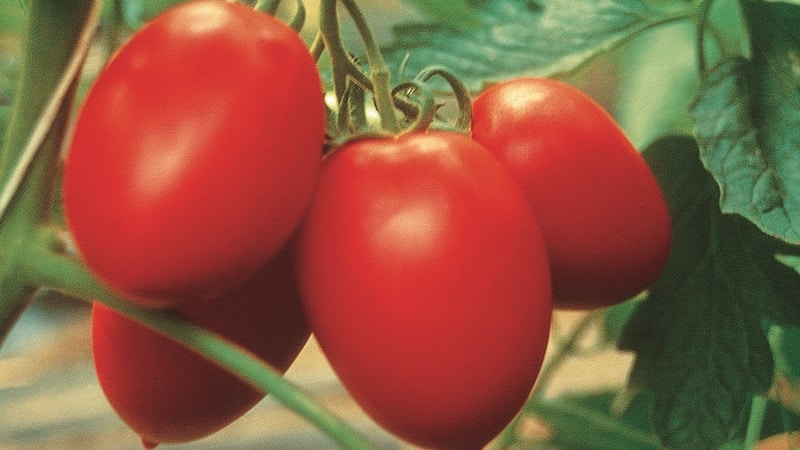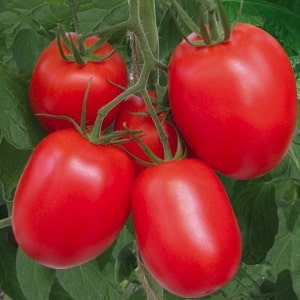We grow our own rich harvest of Hummingbird tomatoes for salads, juices and canning
When developing new varieties, breeders experiment with the shape, size, taste and color of the fruit. The difficulties that farmers face when growing this crop do not go unnoticed.
Tomatoes appear on horticultural markets that are distinguished by their immunity to many plant diseases, high yields and ease of care. These include the hybrid Kolibri F1.
Description of the variety
The Kolibri tomato variety is a first generation hybrid. This is indicated by the designation f1.
The hummingbird was bred by French breeders. The variety belongs to heat-loving crops. Designed for growing in greenhouses and greenhouses.
Characterized by persistent immunity to many diseases and rare lesions late blight.
Tomato seeds are relatively inexpensive. The variety gives a bountiful harvest. During the season you can harvest an excellent harvest with minimal costs for planting material and chemicals.
Photo of the hybrid:

Characteristics
Tomatoes of the Kolibri variety produce large oblong fruits weighing up to 160 g. Tomatoes have a balanced composition and sweet and sour taste.
Thanks to the large number of fruits on one cluster, more than 10 kg of harvest can be obtained from one Hummingbird bush. Tomatoes are harvested before the first frost.
Kolibri tomatoes are meaty. Inside there are 4-5 chambers with seeds, which, due to the hybridity of the variety, are not suitable for cultivation. The color of the tomato skin and pulp is red.
The fruits are suitable for conservation and fresh consumption. Therefore, the variety can be considered universal.
Characteristics of Hummingbird
The characteristics of the Hummingbird variety will impress the most experienced gardener.
Description of Hummingbird tomatoes:
| Parameter | Indicators |
| Bush type | Indeterminate. Bush with constant growth. It can grow up to 2 m high. The stems and leaf blades are powerful. They have a dark green tint. The root system is developed. |
| Growing method | Belongs to heat-loving, heat-resistant varieties. Recommended for growing in greenhouses (both heated and unheated). |
| Productivity | The variety is high-yielding. Up to 10 fruits grow on one cluster. From 1 sq. m harvest 10-15 kg of tomatoes. |
| Fruit | Bright red inside and out. They have an oblong oval shape. The tomatoes are juicy, dense, fleshy and thick-walled. They have a rich aroma. They have a sweet and sour taste. There are no green veins inside, and green spots outside. |
| Transportability | Good. Tomatoes have thick skin. They can be stored without losing their shape for a month. |
| Ripening time | Early ripening. The ripening period is 95 days. Refers to all-season varieties. |
| Disease resistance | Resistant to verticillium and fusarium wilt, tomato mosaic and nematode. Rarely affected by late blight. |
Growing seedlings
Planting and caring for seedlings is an important point in growing tomatoes. Further results depend on the quality implementation of this task.
Seeds are sown either at the end of February or at the beginning of March. The time for planting is chosen according to the lunar calendar.
Seed preparation
To successfully grow tomatoes, planting material is sorted.It is important to get rid of damaged and plaque-covered seeds.
Seed preparation:
- Hummingbird seeds are pre-treated by soaking in a light pink solution of potassium permanganate. If it is not there, use a soda solution.
- The floating seeds are removed. They won't germinate.
- The material is treated with a growth stimulator. To do this, they are placed in the solution overnight. Instead, you can wrap the seeds in wet gauze, which is constantly moistened until germination.
This is interesting! Before sowing the seeds, make sure they are fresh. Expired ones have low germination rates.

Selection of container and soil
You can buy a container for planting seedlings in a specialized store or make it yourself. Sizes vary depending on the stage of tomato cultivation.
First, the seeds are sown in a large container: in polymer trays, wooden boxes or special cassettes.
After germination, they are transplanted into individual containers: plastic or peat pots, or special tablets.
Advice! If there are no special containers for seedlings, it is not necessary to buy them. Can be made from mayonnaise jars, cut-off bottles, disposable plastic or cardboard coffee cups.
You can prepare the soil yourself or buy it at a specialty store. Purchased soil has a balanced composition with all the necessary elements.
To independently prepare the soil for growing seedlings, you need to mix peat with turf and humus in a 2:1:1 ratio. To enrich, add a little ash and superphosphate.
Advice! Both purchased and self-prepared mixtures are disinfected. To do this, the soil is either watered with a weak solution of potassium permanganate, or calcined at a temperature of 80 ° C and above.
Sowing seeds
So:
- Tomato seeds are buried 1 cm into the ground. Leave a distance of at least 0.5 cm between the seeds.
- The earth is moistened with water at room temperature.
- The container is covered with film on top and placed on the windowsill. The room temperature should not fall below 25° C.
- It is important to regularly ventilate the seedlings. This will help avoid moisture stagnation and mold development. In warm weather, the film is opened daily for several hours.
The main points of growing Hummingbird tomato seedlings
 Powerful and healthy seedlings will take root better when transplanted into the ground. Several rules will help you get this result.
Powerful and healthy seedlings will take root better when transplanted into the ground. Several rules will help you get this result.
Rules for growing seedlings:
- Watered seedlings as the soil dries with a spray bottle. Plants should not be flooded or allowed to dry out.
- It is important to maintain not only the humidity level in the room, but also the optimal temperature.
- After the leaves appear, the seedlings are planted in individual containers.
- 10 days after transplantation, feed with complex fertilizers.
- Before planting in the ground, the seedlings are hardened: two weeks before transplanting, they are taken out to the balcony or outside for several hours in the warm season.
Growing tomatoes
Tomato Hummingbird - greenhouse variety. In a greenhouse, you can get the most abundant harvest. At the same time, the plants are resistant to heat and frost.
Hummingbirds are easy to care for, rarely get sick, and have good yields even in the absence of regular feeding. A novice gardener can easily cope with growing a hybrid.
Planting seedlings in the ground
The seedlings are transplanted into an unheated greenhouse two months after the seeds germinate. Planting takes place in the middle or end of May. By this time, the morning frosts have already subsided.
Compost and ash are added to the soil for planting tomatoes. Undiluted manure should not be added; such fertilizer will lead to the death of tomatoes.
Plants are buried down to the cotyledon leaves. This creates a powerful root system.
Planted according to the 70X50 pattern. Placing tomatoes too close will reduce the yield and increase the risk of pests and diseases.
The first watering is five days after transplanting the tomatoes into the greenhouse. Before this, you need to loosen the ground around the bushes.
Nuances of care
Watering is an important point in plant care. Performed in the morning once a week. In hot weather, the number of weekly waterings is increased to 3 times and the soil is regularly loosened. This will ensure air flow to the roots.
The manufacturer recommends forming Kolibri into two stems - this increases the yield.
New shoots on bushes must be removed. You also need to deal with the leaves at the bottom of the plant, yellowed and wilted greenery.
Stepping is done in the morning. On the day of the procedure, the plant is not watered.
The Hummingbird tomato is a crop with constant growth, and therefore requires obligatory garter.
Growth stimulants improve the quality of bushes and accelerate the formation of ovaries. For these purposes, nitrogen, phosphorus and potassium fertilizers are used once every 2 weeks.
A solution of boric acid is a foliar feeding that will accelerate the appearance of fruits. Complex fertilizers can also be used for tomatoes.
Growing Tips
Experienced gardeners give effective advice:
- Carefully weed the weeds around the bushes. They can lead to the death of cultivated plants.
- Use gloves when picking tomatoes.The juice of this plant can cause an allergic reaction if it comes into contact with the skin.
- Once a week you can spray the leaves of the plant with water. More often it is impossible to avoid infection with late blight.
Disease and pest control
The Kolibri tomato is resistant to most existing diseases, which makes it easier to care for and reduces the need for chemical treatment.
Despite the fact that the hybrid is resistant to many plant diseases, it is often attacked by insects. Therefore, it is necessary to take measures in advance to combat pests.
The first step in insect control is to remove all weeds to avoid attack by mole crickets and slugs.
Aphids love tomato greens. Timely treatment of the bushes with a weak soap solution will save you from it.
To prevent the plant from getting late blight, monitor the humidity level in the greenhouse, preventing it from increasing. To do this, carry out regular ventilation.
Harvest and use
In mid-summer, the first ripe fruits appear on the Hummingbird bushes. Tomatoes are harvested by hand, leaving the stem, which will help them last longer and ripen faster.
It is important to pick ripe tomatoes in a timely manner to prevent late blight from damaging unripe fruits.
Green fruits ripen when picked. After two weeks, it is difficult to distinguish them from tomatoes that have ripened in the garden.
Kolibri tomatoes have a sweet and sour taste. According to reviews from gardeners, they are ideally suited for conservation.

Pros and cons of the Hummingbird hybrid
Advantages of the variety:
- spicy taste;
- excellent transportability;
- low price;
- resistance to many diseases;
- strong skin;
- high productivity;
- precocity;
- meatiness.
Hummingbird has several disadvantages.This is the impossibility of using seeds from ripe fruits, the need for gartering and pinching.
Farmers' reviews about the variety
Tomato Hummingbird mainly enjoys positive reviews from experienced and novice gardeners.
Farmers' reviews about tomato:
Martynenko Karina, Moscow: “Hummingbird is my favorite variety. I am reaping a bountiful harvest. From 1 sq. meter produces at least 10 kg of tomatoes. I use them for winter preparations and for salads.”
Turner Andrey, Voronezh: “I plant hummingbirds to store them for the winter. Pickled tomatoes do not crack and have a lot of pulp. Really easy to care for and produce a lot of fruit. In my opinion, it’s too sour for salads; I like pink varieties fresh.”
Conclusion
The Hummingbird tomato is a high-yielding hybrid variety whose fruits are large, red and fleshy. It is easy to care for, resistant to many diseases, and stores well. Application - universal. The variety is successfully grown by both experienced and novice gardeners.